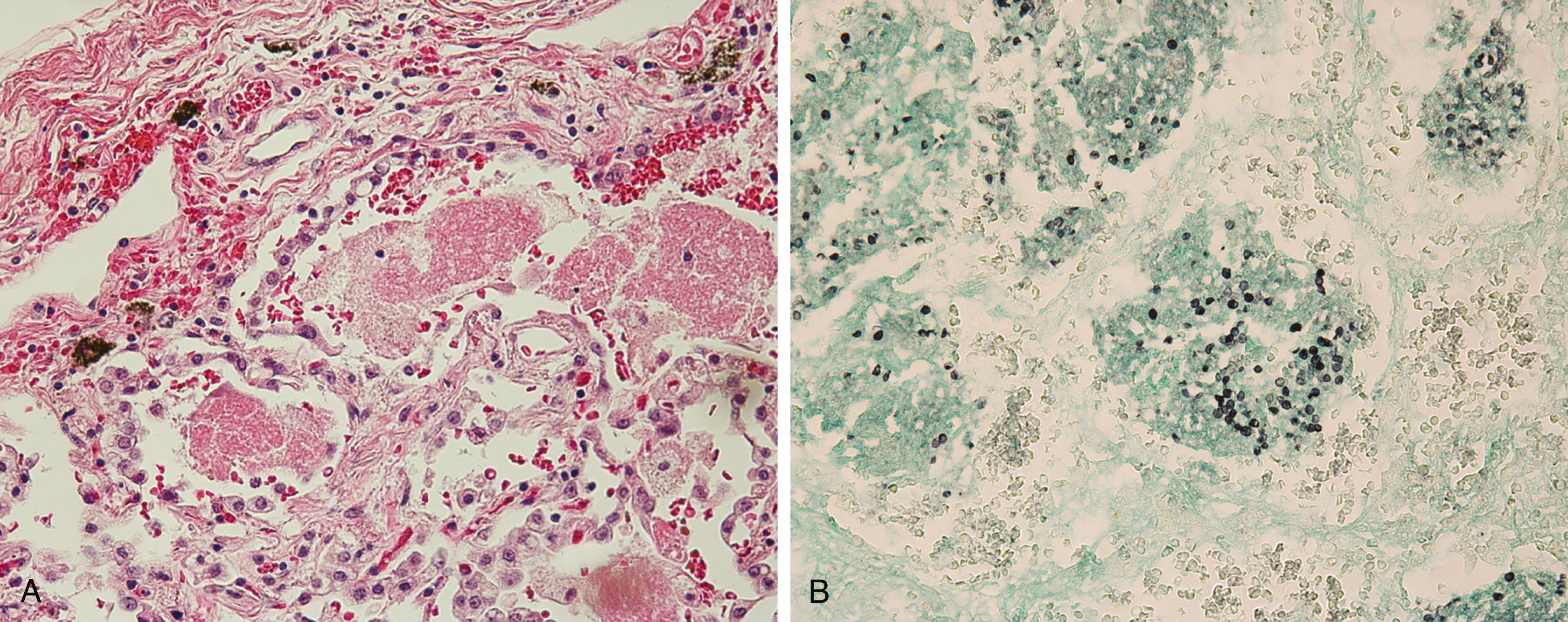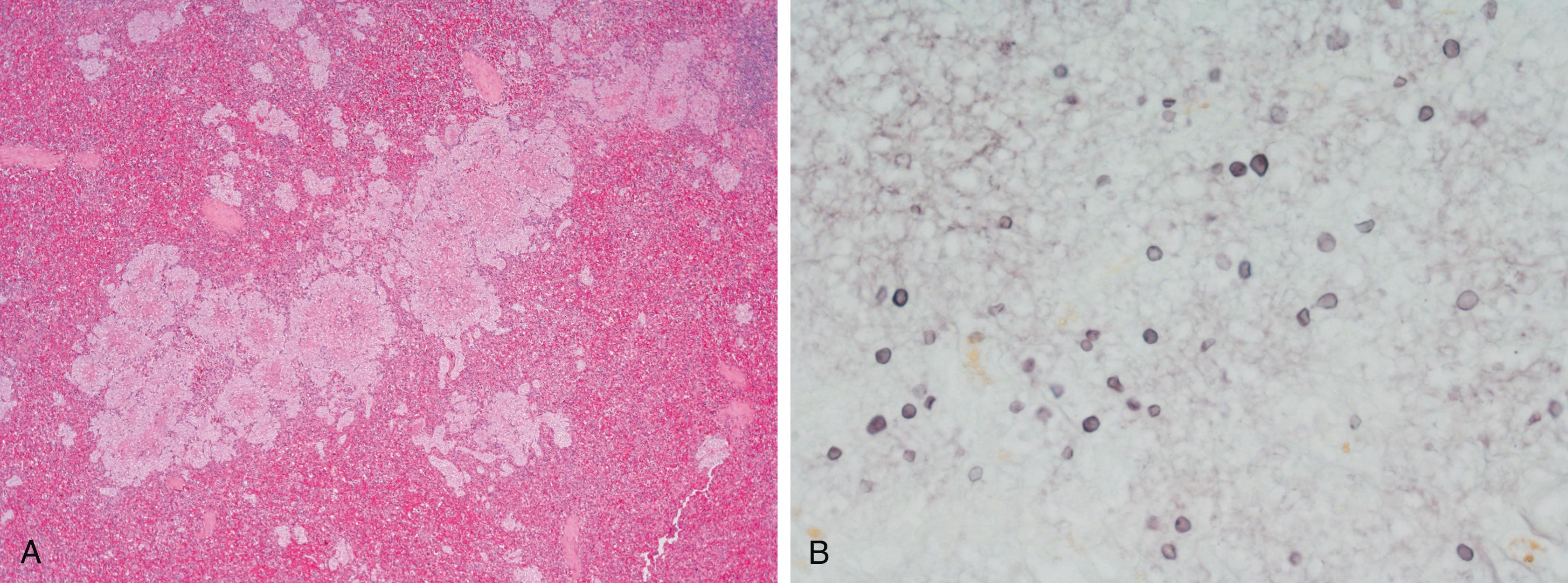Physical Address
304 North Cardinal St.
Dorchester Center, MA 02124
Pneumocystis jirovecii is a fungus that causes pneumonia almost exclusively in immunodeficient patients. Pneumocystis pneumonia (PCP) has been the most common life-threatening opportunistic infection in persons infected with human immunodeficiency virus (HIV), especially those with acquired immunodeficiency syndrome (AIDS). Although the frequency of PCP has decreased in HIV-infected patients, first in association with the widespread use of anti- Pneumocystis prophylaxis and later with the introduction of effective combination antiretroviral therapy for HIV/AIDS, it continues to be seen commonly in HIV-infected and other immunodeficient patients. The risk of PCP has been increasing among renal transplant recipients, especially in Europe and Australia.
Pneumocystis is an ascomycete fungus of the subphylum Taphrinomycotina, most closely related to Schizosaccharomyces , Taphrina , and Saitoella species of fungi. Molecular studies, including whole-genome sequencing, demonstrate that the genus Pneumocystis includes a group of closely related organisms that are unique species, each of which can likely infect only a single host species. The organisms previously called Pneumocystis carinii are reserved for a species that infects rats, whereas the organism infecting humans is named P. jirovecii . Despite the name change, PCP (for P neumo c ystis p neumonia) remains the preferred acronym for human disease.
Pneumocystis species show a fairly strict host specificity: attempts to transmit, for example, rat or human Pneumocystis to mice have been unsuccessful. Molecular evolutionary studies suggest that Pneumocystis species coevolved with their hosts, with host jumps rarely occurring. Pneumocystis does not grow in culture for a sustained period, so its life cycle is unknown. The two easily recognized forms of the organism are trophic forms (about 2 to 6 µm in diameter) and cysts (also called asci; about 5 to 8 µm in diameter), which can contain up to eight intracystic bodies (ascospores); additional intermediate forms are also seen. Trophic forms, which have an amorphous shape, are estimated to outnumber cysts, which are spherical, by approximately 10:1 in an infected lung.
The genome of P. jirovecii , approximately 8.2 million base pairs, is markedly contracted compared with other fungi and has lost multiple metabolic pathways, including enzymes needed to synthesize all amino acids de novo, enzymes needed for chitin synthesis and degradation, and carbonic anhydrase, an enzyme important for regulation of intracellular pH. These findings suggest that Pneumocystis lives exclusively in the mammalian host and cannot survive in the external environment other than for the brief periods of time needed to transmit infection to another host.
Pneumocystis has a worldwide distribution based on serologic studies that show a high prevalence of anti- Pneumocystis antibodies in all studied populations. In America and Europe, serologic studies show that most humans develop antibodies to Pneumocystis by an early age, thereby suggesting that the organism is ubiquitous.
Pneumocystis is transmitted by the respiratory route, and cysts are required for transmission. There is no evidence that water or fomites play a role in transmission. Data also suggest that transmission can occur transplacentally.
Given its strict host specificity, the source of human infection is presumably other humans, as suggested by occasional outbreaks of a single genotype, especially in recipients of renal transplants. Since clinically apparent PCP is rare and nearly all healthy humans are infected at a young age, Pneumocystis infection is also likely acquired from apparently healthy humans, in whom subclinical infection (either asymptomatic or minimally symptomatic) must be quite common.
Molecular genotyping has shown that clinical PCP is often caused by newly acquired strains; whether reactivation of latent infection that was acquired at an early age also contributes to development of pneumonia is unknown. In patients who develop recurrent PCP, however, the recurrence can be due to relapse, especially for early recurrences, or to reinfection with a novel strain.
In immunocompetent hosts, Pneumocystis does not appear to cause significant disease. Clinically significant PCP occurs almost exclusively in patients with severe levels of immunodeficiency that are usually associated with a high risk for other opportunistic pathogens: individuals with congenital immunodeficiencies ( Chapter 231 ), especially severe combined immunodeficiency (SCID), hyper–immunoglobulin M (IgM) syndrome, and, to a lesser extent, interleukin-21 (IL-21) receptor deficiency; patients with HIV infection ( Chapter 354 ) and human T-lymphotropic virus-1–associated lymphoma ( Chapter 171 ); patients receiving chemotherapy for the treatment of malignancies, especially lymphoma; transplant patients receiving immunosuppressive therapy; and patients being treated with prolonged courses of immunosuppressive drugs ( Chapter 28 ), especially corticosteroids. In non-HIV patients, up to 90% of patients may be receiving corticosteroid therapy, and higher dose and longer duration increase the risk. Not all patients who receive corticosteroids are at risk, however; for instance, asthmatic patients receiving corticosteroid therapy are at low risk. Biologic agents ( Chapter 29 ), such as alemtuzumab, rituximab, and agents targeting tumor necrosis factor-α (TNF-α), are also associated with an increased absolute risk for PCP, as are idelalisib, ibrutinib, gemcitabine, and iguratimod.
Risk factors for non–HIV-infected patients include underlying disease, older age, use of immunosuppressive drugs, radiation therapy, graft-versus-host disease, graft rejection, and concomitant cytomegalovirus infection ( Chapter 347 ). Patients with malignancies, especially hematologic malignancies but increasingly solid tumors as well, are at risk for PCP primarily owing to the therapies they receive; the incidence can range from 1 to 43% in the absence of prophylaxis and is highly dependent on the intensity and duration of immunosuppression. The incidence of PCP in patients who are receiving chemotherapy for acute myeloid leukemia may be as high as 6 to 7%. In the absence of prophylaxis, the risk for developing PCP in transplant patients, whether hematopoietic stem cell transplantation ( Chapter 163 ) or solid organ transplantation ( Chapter 38 ), is reportedly about 5 to 15%, although lung and heart-lung transplant patients appear to have a higher incidence (up to 43%). Among patients who have a collagen vascular disease, the reported risk is less than 2% without prophylaxis, although patients who have granulomatosis with polyangiitis ( Chapter 249 ) reportedly have a risk of up to 12%. In patients with inflammatory bowel disease ( Chapter 127 ), the incidence is about 1% per year, with a greater risk for Crohn disease compared with ulcerative colitis. PCP also can occur together with coronavirus disease 2019 (COVID-19) infection ( Chapter 336 ) or during the recovery phase, in part probably related to the use of corticosteroids to treat COVID-19.
Among patients with HIV infection, patients with CD4 counts less than 200 cells/μL, and especially those with CD4 counts less than 100 cells/μL, are at greatest risk. Patients with a prior history of PCP and those with unexplained fever, weight loss, or thrush are also at increased risk. Among non-HIV patients, CD4 counts less than 200 cells/μL also appear to increase risk.
Exposure for as little as 1 day to a Pneumocystis -infected animal results in transmission of infection. Pneumocystis has evolved mechanisms to avoid host initial innate and adaptive immune responses, presumably to facilitate the establishment of primary infection and reinfection in immunocompetent hosts. β-Glucans are masked by surface proteins, and enzymes needed to synthesize outer chain mannans have been lost; both can be recognized by host pattern recognition receptors. The most abundant surface protein of Pneumocystis , the major surface glycoprotein, is found on both cysts and trophic forms and is encoded by a multicopy gene family, only one of which is apparently expressed in a given organism; this provides Pneumocystis with the potential for antigenic variability. Although more than one Pneumocystis species can infect a single animal host species (e.g., rats, dogs), to date only a single Pneumocystis species has been found to infects humans; however, molecular typing techniques have demonstrated a high level of diversity among human Pneumocystis isolates.
In animal models, an adaptive immune response, which develops against primary infection by approximately 5 to 6 weeks, leads to control and clearance before the burden of organisms produces symptoms. CD4 cells are critical to this control, although B cells and macrophages also are important; B cells appear to have a major role in antigen presentation. CD8 cells can contribute to the associated inflammation. In immunodeficient animal models, the inability to control Pneumocystis replication leads to severe pneumonia by 2 to 3 months.
Host inflammatory responses, in part attributable to organism-derived β-glucans, appear to play a critical role in the development of pulmonary symptoms. This relationship may explain why symptoms of PCP develop in patients in whom corticosteroids are being tapered, as well as why the exacerbations of hypoxia can develop approximately 4 days after the initiation of anti- Pneumocystis therapy in the absence of concomitant corticosteroid therapy.
Lung pathology in patients with PCP demonstrates an acellular, foamy, eosinophilic, intra-alveolar exudate associated with mild interstitial inflammation ( E-Fig. 313-1 ). This exudate is composed almost entirely of Pneumocystis organisms. With progressive disease, hyaline membranes form, and interstitial and intraluminal fibrosis develops. Atypical pathology, including noncaseating granulomas and intrapulmonary cystic changes, can also be seen. FLOAT NOT FOUND

In addition to the previously noted congenital immunodeficiencies and acquired immunosuppression, rare dominant negative allelic variants in the transcription factor Ikaros also appear to confer a very high risk of PCP. Among HIV-infected patients, polymorphisms in the genes for FcγRIIa, IL-4, and the chemokine receptor gene for CCRL2 also have been associated with an increased risk.
Although Pneumocystis cannot be cultured, molecular studies have identified mutations in genes that are the targets of anti- Pneumocystis therapy, and these mutations may represent the development of resistance by Pneumocystis to these agents. Mutations in the DHPS gene of Pneumocystis , which is the target of sulfamethoxazole and dapsone, occur more frequently in patients who are receiving trimethoprim-sulfamethoxazole or dapsone for prophylaxis.
In immunocompetent humans, no well-defined clinical syndrome is associated with Pneumocystis infection, although clinically significant pneumonia rarely has been reported in adults. Pneumocystis also has been detected by polymerase chain reaction (PCR) testing in patients with chronic obstructive pulmonary disease (COPD; Chapter 76 ), but it has not been associated with a worsening clinical course.
In immunosuppressed patients, pneumonia is the primary clinical manifestation of Pneumocystis infection. PCP typically presents with a fever, nonproductive cough, and shortness of breath that initially occurs only on exertion but, without therapy, inevitably progresses to dyspnea at rest. Symptoms may be insidious, developing over the course of a few weeks, as is common in patients with HIV infection, or over the course of only a few days, as is more common in non-AIDS patients. Purulent sputum production is unusual, and chills and chest pain occur in a minority of patients. Patients with HIV infection may present with other manifestations of immunodeficiency, including weight loss and thrush. In non-AIDS patients, in whom corticosteroids ( Chapter 28 ) are a common risk factor, clinical manifestations may develop as corticosteroids are being tapered, presumably representing the unmasking of an inflammatory response to the infection as immunosuppression is decreased.
Extrapulmonary disease can rarely involve the skin, eye (choroiditis), central nervous system, bone marrow, thyroid, spleen, liver, gastrointestinal tract, lymph node, or multiple organs in disseminated disease ( E-Fig. 313-2 ), with or without concurrent pneumonia. The risk is somewhat higher but still extremely rare in HIV-infected patients who use aerosolized pentamidine for prophylaxis. Symptoms, which are related to the particular involved site, may be nonspecific, and the diagnosis is often made at autopsy. FLOAT NOT FOUND

Become a Clinical Tree membership for Full access and enjoy Unlimited articles
If you are a member. Log in here